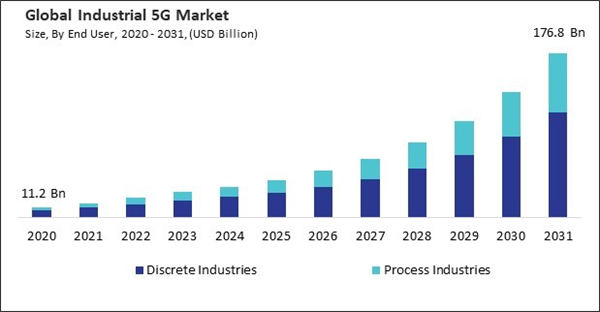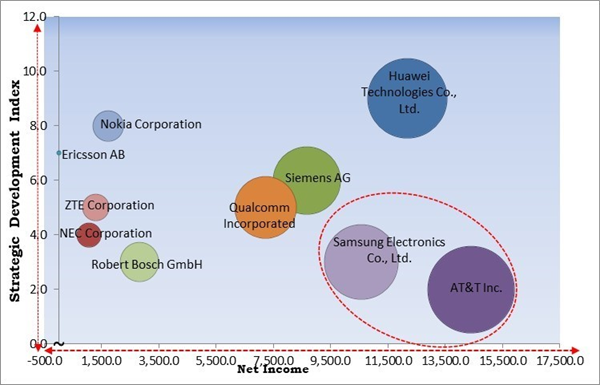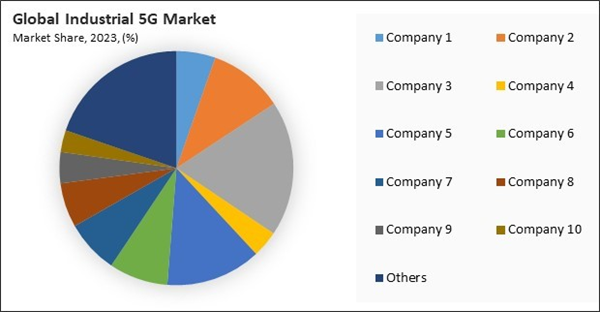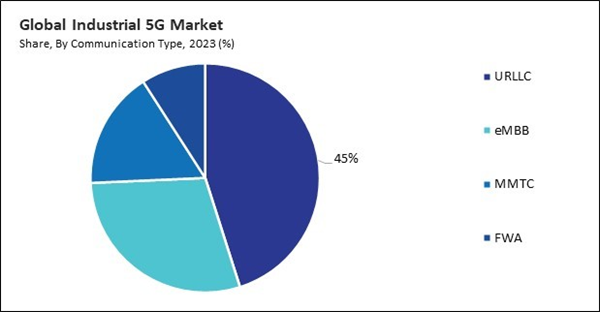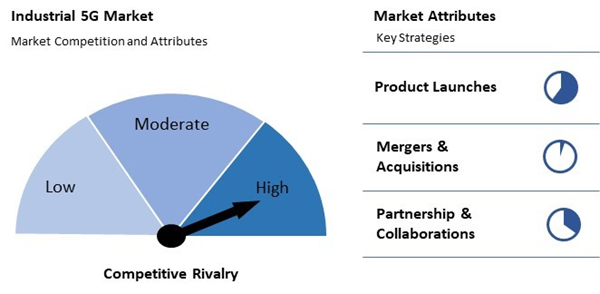In 2023, the Asia Pacific region generated 43% revenue share in the industrial 5G market in 2023. This region is characterized by rapid industrialization, urbanization, and a growing emphasis on technological advancements. Countries such as China, Japan, and South Korea are leading the way in adopting 5G technology to enhance their manufacturing capabilities and improve supply chain management.
The major strategies followed by the market participants are Product Launches as the key developmental strategy to keep pace with the changing demands of end users. For instance, In September, 2024, Huawei Technologies Co., Ltd. hosted the optical summit themed "Accelerate F5G-A, Amplify Intelligence," and unveiled new F5G Advanced products based on the "3 In 3 Out" trends to enhance industrial intelligence. Huawei's initiatives include Fiber-in Copper-out, fgOTN-in SDH-out, and Optical-sensing-in Hard-work-out, urging industry collaboration for smarter, faster connectivity solutions. Moreover, In November, 2023, ZTE Corporation unveiled a 5G-based Industrial Field Network Whitepaper at the 2023 Analyst Conference. This document addresses low latency and high-reliability needs in production and manufacturing, offering solutions for network integration and self-service capabilities while promoting the intelligent transformation of factories amid challenges posed by isolated information silos.
KBV Cardinal Matrix - Market Competition Analysis
Based on the Analysis presented in the KBV Cardinal matrix; AT&T Inc. and Samsung Electronics Co., Ltd. are the forerunners in the Industrial 5G Market. In December, 2022, Samsung Electronics Co., Ltd. unveiled a 16-gigabit DDR5 DRAM using the first 12-nanometer process technology, enhancing performance and efficiency for next-gen computing and AI. The product is compatible with AMD’s platforms, showcasing the importance of collaboration in advancing memory technology for sustainable operations, according to executives from both companies. Companies such as Huawei Technologies Co., Ltd., Siemens AG, and Qualcomm Incorporated are some of the key innovators in Industrial 5G Market.Market Growth Factors
The increasing reliance on real-time data processing and the need for seamless communication across various industries has significantly driven the demand for high-speed and low-latency connectivity. As manufacturing, logistics, and healthcare industries embrace digital transformation, the requirements for faster and more reliable network connections have surged, paving the way for adopting this technology. In conclusion, rising demand for high-speed and low-latency connectivity drives the market's growth.Additionally, Industries are increasingly adopting automation technologies to enhance efficiency and reduce labour costs. They facilitates remote monitoring and control of automated systems, enabling operators to manage processes from afar. The proliferation of Internet of Things (IoT) devices in industrial settings requires reliable, high-speed connectivity to enable real-time data transmission and monitoring. Thus, the increasing need for remote monitoring and control capabilities drives the market's growth.
Market Restraining Factors
Transitioning from previous generations of mobile technology (such as 4G) to 5G often requires substantial upgrades to existing infrastructure, including base stations, antennas, and transmission lines. This can involve high capital expenditures, particularly for industries with limited budgets. 5G networks require a denser network of small cells to provide adequate coverage, especially in urban and industrial areas. Hence, high infrastructure costs associated with 5G deployment hamper the market's growth.The leading players in the market are competing with diverse innovative offerings to remain competitive in the market. The above illustration shows the percentage of revenue shared by some of the leading companies in the market. The leading players of the market are adopting various strategies in order to cater demand coming from the different industries. The key developmental strategies in the market are Product Launches and Product Expansions.
Driving and Restraining Factors
Drivers- Rising Demand For High-Speed And Low-Latency Connectivity
- Increasing Need For Remote Monitoring And Control Capabilities
- Development Of Smart Factories And Industrial Iot Solutions
- High Infrastructure Costs Associated With 5g Deployment
- Interference With Existing Industrial Communication Systems
- Government Initiatives And Investments In Digital Infrastructure
- Expansion In The Precision Agriculture And Smart Farming
- Competition From Alternative Connectivity Solutions
- Environmental Concerns Over Infrastructure Development
Offering Outlook
Based on offering, this market is divided into hardware, software, and services. The software segment attained 18% revenue share in the industrial 5G market in 2023. As industries adopt 5G technology, sophisticated software solutions are required to manage and analyze the enormous quantities of data produced by connected devices. Applications such as network management, data analytics, and automation software are becoming increasingly critical for optimizing operations and ensuring seamless connectivity.Communication Type Outlook
By communication type, this market is divided into eMBB, URLLC, MMTC, and FWA. The eMBB segment procured 29% revenue share in the industrial 5G market in 2023. eMBB primarily delivers high data rates and enhanced mobile connectivity, making it ideal for applications that require substantial bandwidth, such as high-definition video streaming, augmented reality AR, and VR applications.Enterprise Size Outlook
Based on enterprise size, this market is bifurcated into large enterprises and small & medium enterprises. In 2023, the small & medium enterprises segment procured 29% revenue share in the industrial 5G market. SMEs increasingly recognize the importance of adopting 5G technology to remain competitive. The growing availability of affordable 5G solutions and the increasing need for enhanced connectivity to support remote work, automation, and digital services have driven SMEs to invest in 5G capabilities.End User Outlook
On the basis of end user, this market is segmented into process and discrete industries. In 2023, the process industries segment attained 33% revenue share in the industrial 5G market. Process industries include sectors such as oil and gas, chemicals, and pharmaceuticals, where production involves continuous processes rather than discrete assembly. Implementing 5G technology in process industries supports the need for real-time monitoring and control, predictive maintenance, and enhanced safety measures.Regional Outlook
Region-wise, this market is analyzed across North America, Europe, Asia Pacific, and LAMEA. The North America region witnessed 27% revenue share in the industrial 5G market in 2023. The region's strong emphasis on technological innovation, coupled with significant investments in digital infrastructure, has propelled the adoption of 5G technology across various industries. North American countries, particularly the United States and Canada, are at the forefront of integrating advanced technologies such as IoT, artificial intelligence, and big data analytics into their industrial operations.Market Competition and Attributes
The industrial 5G market sees increased competition among smaller and emerging companies. These players focus on niche applications, innovative solutions, and regional market dominance. Partnerships and collaborations with technology providers are common, with firms leveraging 5G’s potential for IoT, automation, and smart manufacturing solutions.
Recent Strategies Deployed in the Market
- Sep-2024: Ericsson AB unveiled its Enterprise 5G strategy, offering private and neutral host 5G solutions to enhance business-critical connectivity for carpeted and industrial enterprises. These solutions improve innovation, safety, and operational efficiency, addressing the limitations of Wi-Fi and DAS with Ericsson’s advanced radio, software, and managed operations capabilities.
- Aug-2024: Nokia Corporation teamed up with YellowScan, an Electronics manufacturer Company to enhance industrial operations by integrating the YellowScan Surveyor Ultra LiDAR scanner with Nokia's Drone Networks. This collaboration aims to automate 5G-based LiDAR scanning for inspections in telecommunications, utilities, and mining, potentially reducing operational costs by over 60% while enabling real-time data streaming and accurate digital twins.
- Jun-2024: At MWC Shanghai 2024, Huawei Technologies Co., Ltd. unveiled the 5G-A Pioneers Program, gathering global operators to discuss advancing 5G-A networks. With the official release of 3GPP Release-18, 2024 marks the first year of commercial 5G-A deployment, aimed at expanding business opportunities and driving long-term growth toward an intelligent future.
- Feb-2024: Ericsson AB teamed up with du, from EITC, to provide Ericsson Private 5G Networks in the UAE. This collaboration aims to enhance secure, reliable 4G and 5G connectivity for government and enterprise sectors, accelerating Industry 4.0 adoption, smart services, and digital transformation, supporting the UAE’s technology-driven economic growth vision.
- Feb-2024: ZTE Corporation announced the partnership with CelcomDigi Berhad, a communications conglomerate and mobile service provider to enhance Malaysia's manufacturing and warehousing through 5G technology. They will utilize ZTE's Digital Twin technology, 5G Automated Guided Vehicles, and Smart Helmets to improve automation, productivity, and safety in the industry, advancing towards "lights-out" factories.
List of Key Companies Profiled
- AT&T Inc.
- Ericsson AB
- Huawei Technologies Co., Ltd. (Huawei Investment & Holding Co., Ltd.)
- NEC Corporation
- Nokia Corporation
- Qualcomm Incorporated (Qualcomm Technologies, Inc.)
- Samsung Electronics Co., Ltd. (Samsung Group)
- ZTE Corporation
- Siemens AG
- Robert Bosch GmbH
Market Report Segmentation
By End User- Discrete Industries
- Automotive & Transportation
- Industrial Machinery & Heavy Equipment
- High-Tech & Consumer Electronics
- Consumer Electronic Devices
- Laptops, Mobile Devices & PCs
- Wearables
- Televisions
- Other Consumer Electronic Devices Types
- Semiconductor & IT Equipment
- Consumer Electronic Devices
- Aerospace & Defense
- Other Discrete Industries Type
- Process Industries
- Large Enterprises
- SMEs
- Hardware
- Software
- Services
- URLLC
- eMBB
- MMTC
- FWA
- North America
- US
- Canada
- Mexico
- Rest of North America
- Europe
- Germany
- UK
- France
- Russia
- Spain
- Italy
- Rest of Europe
- Asia Pacific
- China
- Japan
- India
- South Korea
- Singapore
- Malaysia
- Rest of Asia Pacific
- LAMEA
- Brazil
- Argentina
- UAE
- Saudi Arabia
- South Africa
- Nigeria
- Rest of LAMEA
Table of Contents
Companies Mentioned
Some of the key companies profiled in this Industrial 5G Market include:- AT&T Inc.
- Ericsson AB
- Huawei Technologies Co., Ltd. (Huawei Investment & Holding Co., Ltd.)
- NEC Corporation
- Nokia Corporation
- Qualcomm Incorporated (Qualcomm Technologies, Inc.)
- Samsung Electronics Co., Ltd. (Samsung Group)
- ZTE Corporation
- Siemens AG
- Robert Bosch GmbH



